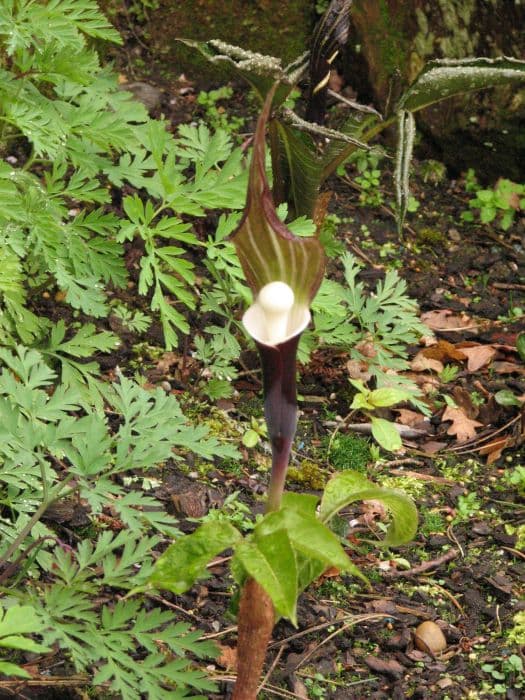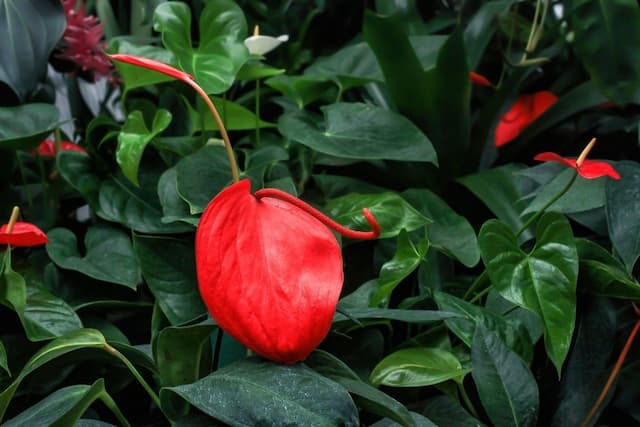Himalayan Cobra Lily Arisaema consanguineum

ABOUT
Arisaema consanguineum, commonly known as Himalayan Cobra Lily, is a distinctive plant that is notable for its sophisticated structural features. The plant reacts strongly to the onset of the warm season when it starts to manifest its features prominently. An eye-catching characteristic is the leaf structure, which consists of a long central stalk that branches out into multiple leaflets. These leaflets are radiating and lance-shaped with a glossy texture that catches the light. They form a circular pattern, much like the spokes of an umbrella, and are deep green in color, which can sometimes display subtle variegations. The flower of the Himalayan Cobra Lily is particularly dramatic and draws parallels with its namesake, the cobra, because of its shape. Enclosed in a hood-like structure, the spadix, which is the reproductive organ of the plant, sticks out and is reminiscent of a snake's head. The spathe, forming the hood, is notable for its striking color – it can range from a deep green to a purplish hue and is often streaked or spotted, adding to the exotic allure. The spathe enfolds the spadix, and together, they create a mysterious and otherworldly appearance that is unique among flowering plants. The plant has a sturdy stalk that anchors it firmly in the soil, allowing it to bear the weight of the large leaves and the intriguing flower structure. This stalk emerges from a tuber that lies dormant underground during the cold months, storing energy for the growing season. The overall impression of the Himalayan Cobra Lily is one of elegance and mystery, with its serpentine flower and lush, radial foliage. It is a captivating addition to any garden space that favors plants with a dramatic and tropical ambiance.
About this plant
 Names
NamesSynonyms
Chinese Jack-In-The-Pulpit, Himalayan Cobra Lily
Common names
Arisaema consanguineum Schott, Arum consanguineum Kunth, Arisaema erubescens Wall., Arisaema erubescens var. consanguineum Engler, Arisaema erubescens f. consanguineum F.T. Wang &Tang, Arisaema heterophyllum H. Li, Arisaema lobatum Buchet, Arisaema mairei H. Lév., Arisaema triphyllum Blume, Arisaema erubescens var. typicum Engl.
 Toxicity
ToxicityTo humans
Arisaema consanguineum, commonly known as the Himalayan cobra lily, contains calcium oxalate crystals which can be toxic if ingested. Chewing or biting into this plant can release these crystals causing tissue penetration & irritation to the mouth & GI tract. Symptoms may include intense burning and irritation of the mouth, tongue, and lips, excessive drooling, vomiting, and difficulty swallowing. In severe cases, swelling can lead to difficulty breathing and can be potentially life-threatening.
To pets
The Himalayan cobra lily is toxic to pets due to the presence of calcium oxalate crystals. If a pet ingests any part of the plant, symptoms can include oral irritation, pain and swelling of mouth, tongue and lips, excessive drooling, vomiting, and difficulty swallowing. In severe cases, ingestion can lead to respiratory problems if swelling obstructs the airway. Immediate veterinary care is recommended if a pet has ingested this plant.
 Characteristics
CharacteristicsLife cycle
Perennials
Foliage type
Deciduous
Color of leaves
Green
Flower color
Green
Height
1-2 feet [30-60 cm]
Spread
1-2 feet [30-60 cm]
Plant type
Herb
Hardiness zones
6
Native area
Asia
Benefits
 General Benefits
General Benefits- Ornamental Value: Arisaema consanguineum, commonly known as the Chinese cobra lily, is valued for its striking foliage and unique, hooded flowers, which add an exotic touch to gardens and landscapes.
- Ecosystem Support: Provides food for pollinators, such as certain insects that are attracted to the flowers, thus supporting local ecosystems.
- Soil Stabilization: The roots can help stabilize soil, reducing erosion on slopes or in areas with loose soil.
- Shade Tolerance: Being a woodland species, it is capable of growing in shaded areas where other plants may not thrive, offering gardeners more planting options.
- Humidity Tolerance: It is tolerant of high humidity, making it suitable for planting in moist and woodland environments.
- Cultural Significance: In some regions, it holds cultural significance and may be used in traditional landscaping practices.
 Medical Properties
Medical Properties- Analgesic: Arisaema consanguineum has been used in traditional medicine as a pain reliever.
- Anti-inflammatory: Some compounds in the plant may have effects that reduce inflammation.
- Antirheumatic: Traditionally, it has been used to treat rheumatic pain.
- Antitumor: There is some evidence suggesting it may have antitumor properties, although further research is needed to confirm this.
 Air-purifying Qualities
Air-purifying QualitiesThis plant is not specifically known for air purifying qualities.
 Other Uses
Other Uses- The tubers of Arisaema consanguineum, known as the Himalayan Cobra Lily, can be used as a source of starch in times of food scarcity.
- Due to its striking appearance, the plant is often incorporated into garden designs and landscapes for ornamental purposes.
- The fibers extracted from the plant can be used in the construction of small crafts and for weaving baskets in certain cultures.
- Its unique inflorescence can be studied by botanists and horticultural enthusiasts for educational purposes and to understand the biodiversity within the Arisaema genus.
- The sap of the Himalayan Cobra Lily may be applied to fishing nets as a presumed insect repellent to protect them from damage.
- Artists and photographers may use the plant as a subject in their works due to its visually striking hood-like spathe and overall structure.
- In regions where it grows, the plant can be a source of intrigue in ecotourism, attracting visitors interested in exotic flora.
- The plant's seeds can be propagated for conservation purposes to maintain genetic diversity within the species and for reforestation efforts.
- Culturally, it may play a role in rituals or ceremonies, where it represents certain symbolic meanings related to its appearance.
- Botanical illustrators may utilize the Himalayan Cobra Lily as a specimen for detailed botanical drawings, contributing to scientific documentation and artistry.
Interesting Facts
 Feng Shui
Feng ShuiThe Chinese Cobra Lily is not used in Feng Shui practice.
 Zodiac Sign Compitability
Zodiac Sign CompitabilityThe Chinese Cobra Lily is not used in astrology practice.
 Plant Symbolism
Plant Symbolism- Mystery: Arisaema consanguineum, commonly known as Himalayan Cobra Lily, has a unique and exotic flower shape that resembles a cobra's hood, creating an air of mystery and intrigue.
- Protection: The flower's hooded form is thought to symbolize shelter and protection, as it appears to safeguard the inner parts of the flower.
- Healing: In traditional medicine, parts of the Himalayan Cobra Lily have been used for healing purposes, thus it is often associated with health and healing.
- Fascination with the exotic: Its unusual appearance and rarity in cultivation make it a symbol of fascination with the exotic and the allure of the unknown.
 Water
WaterThe Himalayan Cobra Lily should be watered thoroughly once the top inch of the soil feels dry to the touch. Typically, this might mean watering approximately every 7 to 10 days, but this frequency can vary depending on environmental conditions like temperature and humidity. When watering, slowly pour water until it begins to drain from the bottom of the pot, indicating the soil is saturated; this may equate to around 1 to 2 gallons for a medium-sized plant. During the dormant period in winter, reduce watering significantly, providing just enough to prevent the soil from completely drying out.
 Light
LightThe Himalayan Cobra Lily thrives in bright, indirect light, away from direct sunlight, which can scorch its leaves. An ideal location would be near an east-facing window where it can receive gentle morning light or a few feet away from a south or west-facing window where the light is more diffused. Too little light can lead to poor growth, so ensure it receives adequate brightness without direct exposure.
 Temperature
TemperatureFor optimal growth, the Himalayan Cobra Lily prefers temperatures between 60°F and 75°F. It can tolerate a short period of colder temperatures down to about 45°F and warmer temperatures up to about 85°F, but prolonged exposure to extremes can be detrimental. Maintaining an environment within this temperature range is ideal for the health and vitality of the plant.
 Pruning
PruningPruning Himalayan Cobra Lily is not typically required for this plant's health but can be done to remove any yellowed or dead foliage. This light pruning can be performed as needed, regardless of the season, to maintain aesthetics and encourage good air circulation among the leaves. It’s best to do any significant pruning just after the plant goes dormant in the fall or before new growth begins in the spring.
 Cleaning
CleaningAs needed
 Soil
SoilHimalayan Cobra Lily, Arisaema consanguineum, thrives in well-draining soil with high organic matter. The best mix is a blend of loam, peat, and perlite or sand at ratios conducive to moisture retention yet allowing excess water to escape. Maintaining a soil pH of around 5.5 to 6.5 will create optimal conditions for this species.
 Repotting
RepottingHimalayan Cobra Lily should be repotted every two to three years or when it outgrows its pot. It's best to repot during the plant's dormancy period, which is typically in late summer to early fall, once the foliage has died back.
 Humidity & Misting
Humidity & MistingHimalayan Cobra Lily prefers high humidity levels, ideally between 60% to 80%. Consistently high humidity will help mimic its native mountainous habitats and encourage healthy growth.
 Suitable locations
Suitable locationsIndoor
Ensure bright light, high humidity, and cool temps for Himalayan Cobra Lily.
Outdoor
Choose partial shade, well-draining soil, shelter from wind for Himalayan Cobra Lily.
Hardiness zone
6-9 USDA
 Life cycle
Life cycleArisaema consanguineum, commonly known as Chinese jack-in-the-pulpit, begins life as a seed that germinates to produce a small tuber, which will enter a period of dormancy over winter. After dormancy, in early spring, a single leaf sprouts from the tuber, followed by the unique flower structure, or spadix, enclosed by a hood-like spathe. Once pollinated, typically by flies attracted to the spathe's heat and smell, the plant produces a cluster of bright red berries. These berries are then dispersed, often by birds, facilitating the spread of seeds for the next generation. Over the years, the plant can form larger clumps as it slowly multiplies via offsets from the main tuber. After multiple years, the mature Arisaema consanguineum dies back to the tuber once again in late autumn, completing its annual cycle.
 Propogation
PropogationPropogation time
Spring to Summer
Propogation: Arisaema consanguineum, commonly known as the Himalayan cobra lily, is typically propagated through seed. The optimal time for sowing seeds is in the fall, which allows for a natural stratification process during the cold winter months. After collection, seeds should be sown about half an inch deep (approximately 1.3 cm) in a mix of well-draining soil and kept in a shaded area. Germination can be slow and irregular, potentially taking several months. It's essential to keep the soil consistently moist but not waterlogged to prevent fungal diseases and rot. Once seedlings emerge and establish themselves with a couple of leaves, they can be carefully transplanted into individual pots or directly into the garden in appropriate conditions.









